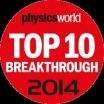From a shortlist of 10 highly commended breakthroughs, the historic achievement by scientists working on the Rosetta mission was singled out by the Physics World editorial team for its significance and fundamental importance to space science.
The landing of the Philae probe, which captivated not only the physics community but millions of people worldwide, was the culmination of 10 years' work by scientists at the European Space Agency (ESA), who successfully guided the Rosetta spacecraft through the inner solar system to finally meet up with Comet 67P/Churyumov-Gerasimenko in August.
At 15:35 GMT on 12 November, a signal was received in the ESA control room confirming that the Philae lander had completed its seven-hour descent and had landed safely on the surface of Comet 67P. While the landing was not as smooth as mission scientists would have liked, the Philae lander still managed to collect a large amount of data before entering hibernation mode.
To celebrate the achievement, Physics World will be hosting a Google Hangout with members of the Rosetta team on Friday 12 December at 14:00 GMT.
Dr Hamish Johnston, editor of physicsworld.com, says: "By landing the Philae probe on a distant comet, the Rosetta team has begun a new chapter in our understanding of how the solar system formed and evolved - and ultimately how life was able to emerge on Earth. As well as looking forward to the fascinating science that will be forthcoming from Rosetta scientists, we also acknowledge the technological tour de force of chasing a comet for 10 years and then placing an advanced laboratory on its surface."
The Physics World editorial team has recognized a further nine achievements from 2014 in a range of topics from nuclear physics to nanotechnology. The top 10 breakthroughs were selected using the following criteria: fundamental importance of research; significant advance in knowledge; strong connection between theory and experiment; and general interest to all physicists.
Dr Johnston continues: "In what was an exciting year for the field of physics, we commend the work of the nine runners-up, each of which represents an important step forward made by a team of creative and talented researchers. Our congratulations are extended to all of those involved."
The remaining breakthroughs (in no particular order) are:
Quasar shines a bright light on cosmic web To Sebastiano Cantalupo, Piero Madau and Xavier Prochaska of the University of California Santa Cruz and Fabrizio Arrigoni-Battaia and Joseph Hennawi of the Max-Planck-Institut für Astronomie in Heidelberg for using the radiation given off by a quasar to catch the first glimpse of a filament of the cosmic web.
Neutrinos spotted from Sun's main nuclear reaction To the Borexino collaboration for being the first to detect neutrinos from the main nuclear reaction that powers the Sun.
Laser fusion passes milestone To Omar Hurricane and colleagues at the National Ignition Facility (NIF) of the Lawrence Livermore National Laboratory and the Los Alamos Laboratory in the US for being the first to obtain a "fuel gain" of greater than one in a laser-driven nuclear fusion experiment.
To Christine Démoré and Mike MacDonald of the University of Dundee in the UK, Patrick Dahl and Gabriel Spalding of Illinois Wesleyan University in the US and colleagues for creating the first acoustic "tractor beam" that can pull an object by firing sound waves at it.
Lasers ignite 'supernovae' in the lab To Gianluca Gregori, Jena Meinecke of the University of Oxford and an international team for using one of the world's most powerful laser facilities to create tiny versions of supernova explosions in the laboratory.
Electrons' magnetic interactions isolated at long last (physicsworld.com/cws/article/news/2014/jun/19/electrons-magnetic-interactions-isolated-at-long-last) To Shlomi Kotler, Nitzan Akerman, Nir Navon, Yinnon Glickman and Roee Ozeri of the Weizmann Institute of Science in Israel for being the first to measure the extremely weak magnetic interaction between two single electrons.
Disorder sharpens optical-fibre images To Arash Mafi and colleagues at the University of New Mexico, University of Wisconsin-Milwaukee, Corning Incorporated and Clemson University for using the phenomenon of "Anderson localization" to create a better optical fibre for transmitting images.
Data stored in magnetic holograms To Alexander Khitun and Frederick Gertz at the University of California Riverside in the US and Alexander Kozhevnikov and Yuri Filimonov at the Kotel'nikov Institute of Radioengineering and Electronics in Russia for creating a new type of holographic memory device based on the interference of spin waves.
Quantum data are compressed for the first time To Aephraim Steinberg and colleagues at the University of Toronto for being the first to demonstrate a quantum analogue of data compression in the lab.
INFORMATION:
Please mention Physics World as the source of these items and, if publishing online, please include a hyperlink to: http://physicsworld.com
Notes for editors:
1. Physics World is the international monthly magazine published by the Institute of Physics. For further information or details of its editorial programme, please contact the editor, Dr Matin Durrani, tel +44 (0)117 930 1002. The magazine's website physicsworld.com is updated regularly and contains daily physics news and regular audio and video content. Visit http://physicsworld.com.
2. For more information regarding the story above, please contact: Mike Bishop, IOP Publishing Senior Press Officer, tel: +44 (0)11 7930 1032, e-mail: michael.bishop@iop.org.
3. The Institute of Physics is a leading scientific society. We are a charitable organisation with a worldwide membership of more than 50,000, working together to advance physics education, research and application.
We engage with policymakers and the general public to develop awareness and understanding of the value of physics and, through IOP Publishing, we are world leaders in professional scientific communications.
In September 2013 we launched our first fundraising campaign. Our campaign, Opportunity Physics, offers you the chance to support the work that we do.
